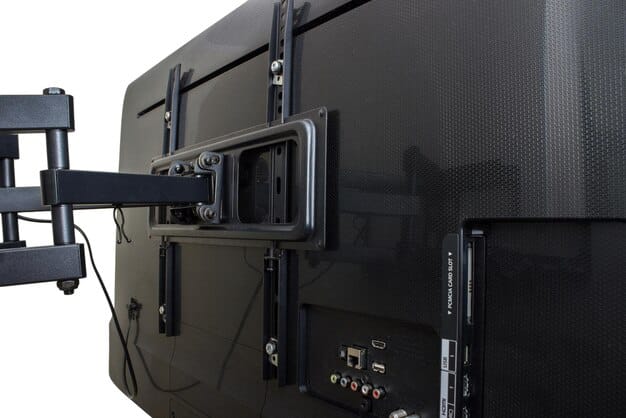The Ultimate Guide to 4K Streaming in 2025: Everything You Need to Know

The Ultimate Guide to 4K Streaming in 2025: What You Need to Know covers advancements, hardware demands, content availability, and cost considerations for an immersive viewing experience.
Are you ready to experience the future of home entertainment? As we approach 2025, 4K streaming is becoming increasingly accessible and sophisticated. But what exactly do you need to make the most of it?
This The Ultimate Guide to 4K Streaming in 2025: What You Need to Know will walk you through everything from the hardware requirements to the best streaming services, ensuring you’re fully prepared for a truly immersive viewing experience. Let’s dive in and explore the world of The Ultimate Guide to 4K Streaming in 2025: What You Need to Know!
Understanding 4K Streaming Technology
To fully grasp the 4K streaming experience, it’s essential to understand the underlying technology. 4K, also known as Ultra High Definition (UHD), offers a significantly higher resolution than standard HD, providing a more detailed and immersive picture.
The Basics of 4K Resolution
4K resolution refers to a horizontal display resolution of approximately 4,000 pixels. The most common 4K resolution is 3840 x 2160 pixels, which is four times the resolution of Full HD (1920 x 1080 pixels). This increase in pixel density results in sharper images, finer details, and a more realistic viewing experience.
HDR (High Dynamic Range) and Its Impact
High Dynamic Range (HDR) is another critical component of modern 4K streaming. HDR enhances the contrast ratio and color accuracy, producing brighter highlights and deeper blacks. This wider range of colors and luminance levels makes the picture look more vibrant and lifelike. HDR formats like HDR10, Dolby Vision, and HLG are commonly used to deliver enhanced visual quality.
The Role of Codecs: HEVC and AV1
Video codecs play a crucial role in compressing and decompressing video data for streaming. High Efficiency Video Coding (HEVC), also known as H.265, has been the standard codec for 4K streaming due to its ability to deliver high-quality video at lower bitrates compared to older codecs like H.264. However, the royalty fees associated with HEVC have spurred the development of alternative codecs like AV1, which is royalty-free and designed to offer even better compression efficiency.
- Higher Resolution: 4K provides four times the resolution of Full HD.
- Enhanced Colors: HDR significantly improves color accuracy and contrast.
- Efficient Compression: Codecs like HEVC and AV1 enable high-quality streaming at lower bandwidths.
In conclusion, understanding these technological aspects is crucial for appreciating the advancements in The Ultimate Guide to 4K Streaming in 2025: What You Need to Know. As technology continues to evolve, we can expect even more improvements in video quality and streaming efficiency.
Hardware Requirements for 4K Streaming
Having the right hardware is crucial to enjoying 4K streaming in its full glory. From TVs to streaming devices and HDMI cables, each component plays a vital role in delivering a seamless and high-quality viewing experience.

4K TVs: What to Look For
When purchasing a 4K TV, it’s essential to consider several key features. Look for TVs that support HDR formats like HDR10 or Dolby Vision for enhanced color and contrast. Ensure the TV has HDMI 2.0 or HDMI 2.1 ports, which are necessary for transmitting 4K content at higher frame rates. A TV with a good upscaling engine can also improve the picture quality of non-4K content.
Streaming Devices: Roku, Apple TV, and More
Streaming devices like Roku, Apple TV, Amazon Fire Stick, and Chromecast are popular options for accessing 4K content. When choosing a streaming device, ensure it supports 4K resolution and HDR. The processing power of the device is also important for smooth playback and navigation. Some devices offer additional features like voice control and integration with smart home ecosystems.
The Importance of HDMI Cables
HDMI cables are essential for transmitting 4K signals from your streaming device to your TV. For 4K streaming, you’ll need an HDMI cable that supports at least HDMI 2.0. HDMI 2.1 is the latest standard and offers even higher bandwidth, allowing for 4K content at higher frame rates and with HDR. Using a high-quality HDMI cable ensures a stable and reliable connection.
- HDR Support: Essential for vibrant colors and contrast.
- HDMI 2.0/2.1: Necessary for transmitting 4K signals.
- Processing Power: Ensures smooth playback and navigation.
In summary, selecting the right hardware is key to enjoying The Ultimate Guide to 4K Streaming in 2025: What You Need to Know. By focusing on these essential components, you can create a setup that delivers stunning visuals and a seamless streaming experience.
4K Streaming Services in 2025: A Comprehensive Overview
The availability of 4K content has expanded significantly, with many streaming services now offering a wide range of movies, TV shows, and documentaries in Ultra HD. Choosing the right streaming services can greatly enhance your 4K viewing experience.
Netflix: The Leader in 4K Content
Netflix is one of the leading streaming services for 4K content, offering a growing library of movies and TV shows in Ultra HD. Many of Netflix’s original productions are filmed in 4K and support HDR formats like Dolby Vision. To stream 4K content on Netflix, you’ll need a premium subscription plan and a compatible device.
Amazon Prime Video: A Strong Contender
Amazon Prime Video is another strong contender in the 4K streaming market. With a wide selection of movies, TV shows, and original content available in Ultra HD, Amazon Prime Video offers a compelling alternative to Netflix. Many titles also support HDR10+ for enhanced picture quality. A Prime membership is required to access 4K content on Amazon Prime Video.
Disney+: Expanding Its 4K Library
Disney+ has quickly become a popular streaming service, offering a vast library of Disney, Pixar, Marvel, Star Wars, and National Geographic content in 4K. Many of Disney’s flagship movies and TV shows are available in Ultra HD with Dolby Vision and Dolby Atmos support, providing an immersive viewing experience. A Disney+ subscription is required to access 4K content.

- Netflix: Extensive library of 4K movies and TV shows.
- Amazon Prime Video: Wide selection of 4K content with HDR10+ support.
- Disney+: Vast library of Disney, Marvel, and Star Wars content in 4K.
With the growing availability of 4K content on various streaming platforms, now is a good time to explore The Ultimate Guide to 4K Streaming in 2025: What You Need to Know and see how each service stacks up in terms of content, pricing, and features. By understanding what each platform offers, you can make an informed decision and tailor your subscription choices to your viewing preferences.
Internet Speed and Bandwidth Requirements
A stable and fast internet connection is crucial for seamless 4K streaming. Insufficient bandwidth can lead to buffering, reduced picture quality, and a frustrating viewing experience. Understanding the internet speed requirements for 4K streaming is essential for optimal performance.
Minimum Internet Speed for 4K Streaming
Most streaming services recommend a minimum internet speed of 25 Mbps for streaming 4K content. However, for a more stable and reliable experience, it’s recommended to have a connection speed of 50 Mbps or higher. If multiple devices are using the internet simultaneously, even higher bandwidth may be required.
Factors Affecting Streaming Quality
Several factors can affect the quality of your 4K stream, including the distance from your router, interference from other devices, and network congestion. Using a wired Ethernet connection instead of Wi-Fi can help improve stability and reduce buffering. Additionally, ensuring your router is up-to-date and properly configured can optimize your internet performance.
Tips for Optimizing Your Network
To optimize your network for 4K streaming, consider upgrading to a faster internet plan, using a wired Ethernet connection whenever possible, and placing your router in a central location. You can also use a Wi-Fi analyzer app to identify and avoid congested channels. Prioritizing streaming traffic through Quality of Service (QoS) settings on your router can also improve performance.
- Minimum Speed: 25 Mbps recommended, 50 Mbps or higher for a better experience.
- Wired Connection: More stable than Wi-Fi.
- Router Optimization: Ensure your router is up-to-date and properly configured.
In conclusion, understanding and meeting the internet speed and bandwidth requirements is vital for enjoying The Ultimate Guide to 4K Streaming in 2025: What You Need to Know. By optimizing your network and ensuring a stable connection, you can minimize buffering and maximize your viewing pleasure.
The Future of 4K Streaming: What to Expect in 2025
As we look ahead to 2025, the landscape of 4K streaming is expected to evolve significantly. Technological advancements, content availability, and consumer preferences will all play a role in shaping the future of Ultra HD entertainment.
Advancements in Streaming Technology
Several advancements in streaming technology are on the horizon. The adoption of more efficient video codecs like AV1 will enable higher-quality streaming at lower bitrates. Improvements in network infrastructure, such as the expansion of 5G and fiber optic networks, will provide faster and more reliable internet connections. Additionally, advancements in display technology, such as MicroLED and OLED, will offer even more stunning visuals.
The Rise of 8K and Beyond
While 4K is currently the standard for Ultra HD streaming, 8K resolution is gradually gaining traction. 8K offers four times the resolution of 4K, providing an even more immersive and detailed picture. While 8K content is still limited, we can expect to see more 8K TVs and streaming services supporting 8K in the coming years. Beyond 8K, even higher resolutions like 16K are being explored, pushing the boundaries of visual fidelity.
The Impact of 5G on Mobile Streaming
The rollout of 5G mobile networks is expected to have a significant impact on mobile streaming. 5G offers much faster speeds and lower latency compared to 4G, enabling high-quality 4K streaming on mobile devices. This will allow users to enjoy Ultra HD content on smartphones, tablets, and other portable devices without worrying about buffering or reduced picture quality.
- Efficient Codecs: AV1 and other codecs will improve streaming efficiency.
- 8K Resolution: The next step in ultra-high-definition viewing.
- 5G Impact: Enhancing mobile streaming capabilities.
In summary, The Ultimate Guide to 4K Streaming in 2025: What You Need to Know is set to be shaped by technological innovation, increased content availability, and evolving consumer preferences. Consumers can anticipate even more immersive, higher-quality streaming experiences as we approach 2025, thanks to breakthroughs in codecs, network technology, and display technologies.
| Key Aspect | Brief Description |
|---|---|
| 📺 4K Resolution | Offers four times the resolution of Full HD for sharper images. |
| ⚡ Internet Speed | Minimum of 25 Mbps recommended; 50 Mbps for optimal streaming. |
| 🎬 Streaming Services | Netflix, Amazon Prime, and Disney+ offer a wide range of 4K content. |
| 🚀 Future Trends | Advancements in codecs, 8K resolution, and 5G will enhance streaming. |
Frequently Asked Questions
To enjoy The Ultimate Guide to 4K Streaming in 2025: What You Need to Know, you’ll need a 4K TV with HDMI 2.0 or 2.1 ports, a 4K-compatible streaming device, and high-speed HDMI cables to ensure a stable connection.
A minimum internet speed of 25 Mbps is recommended for streaming 4K content. However, for a smoother experience, especially with multiple devices, a speed of 50 Mbps or higher is preferable.
Many popular streaming services, including Netflix, Amazon Prime Video, and Disney+, offer a wide range of movies and TV shows in 4K resolution with HDR support for enhanced picture quality.
HDR (High Dynamic Range) enhances the contrast ratio and color accuracy, creating brighter highlights and deeper blacks for a more vibrant and lifelike image. It significantly improves the visual experience.
By 2025, we can expect improvements in video codecs like AV1, the rise of 8K resolution, and the impact of 5G on mobile streaming, all contributing to a more immersive and higher-quality viewing experience.
Conclusion
In conclusion, The Ultimate Guide to 4K Streaming in 2025: What You Need to Know involves understanding the technology, having the right hardware, subscribing to the right services, and ensuring a stable internet connection. As technology continues to evolve, staying informed will help you make the most of your 4K streaming experience.
By following this guide, you’ll be well-prepared to enjoy stunning visuals and immersive entertainment in the comfort of your own home. Get ready to experience the future of streaming!





